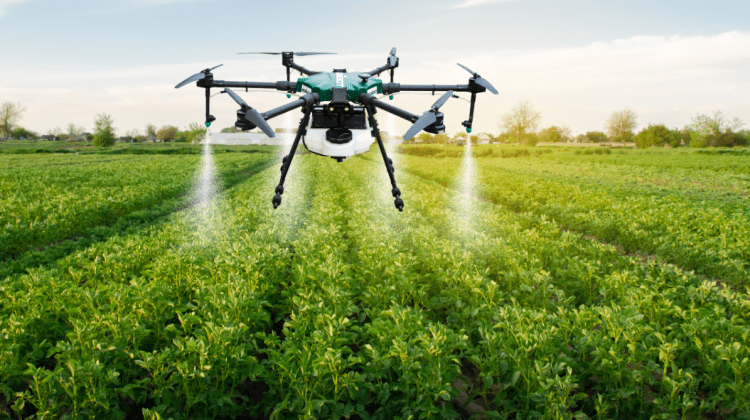
How are Agricultural Drones Shaping the Future of Farming?
Managing farmland and maximising crop yields in India poses immense obstacles. However, recent technological progress in drones and sensors introduces novel prospects to obtain insights into fields and transform agricultural methods. Agricultural drones, outfitted with high-definition cameras and sensors, offer an affordable approach to examining crops from the sky and furnish data to aid in optimising planting, irrigation, and harvesting. By employing drones to track crop wellness, identify pests or sicknesses, and gain enhanced comprehension of the spatial variability in fields, you can elevate productivity and yields while decreasing expenses and environmental influences. For farmers, agricultural drones are primed to form the long-term future of farming in India and beyond.
Types of Drones Used in Agriculture

Various types of drones used in agriculture play essential roles in modern agriculture, each designed with distinct capabilities for specific tasks.
- Fixed-Wing Drones: Fixed-wing drones resemble small aeroplanes and are used for lengthy flights in agriculture. They are perfect for jobs like crop mapping and monitoring. Nevertheless, utilising these drones requires open areas and runways for taking off and landing because of their intricate design.
- Single-Rotor Drones: Single-rotor drones, also known as helicopter drones, reveal their suitability for precise agricultural jobs that require data collection in tight spaces. Due to their ability to hover, ascend, and descend vertically, they can efficiently monitor crops, analyse soil components, and spread pesticides in confined areas.
- Multi-Rotor Drones: While drones with multiple rotors thrive in close-range agricultural jobs like checking crop progress, counting plants, and analysing soil, their usefulness comes with boundaries. Capable of carrying sophisticated cameras and other technology, these aerial robots give farmers detailed bird’s-eye views of fields and orchards to evaluate crop wellbeing and find pests.
- Hybrid Drones: By combining fixed-wing and multi-rotor elements, hybrid drones gain vertical take-off and landing skills, expanded range, and endurance. These types of drones prove ideal for large agricultural enterprises by supplying important observations about crop wellness, soil quality, and irrigation requirements.
Also Read:
- Why are Agricultural drones becoming a better way of farming in India?
- How Drone Technology Is Bringing Environmental Benefits To Farms
Transforming Farming for a Smarter Future

Farming practices are evolving thanks to agricultural drones, making way for a new period of exactness and productivity. These aerial farming drones equipped with sophisticated optics and detectors, are transforming how farm operators gather intelligence, supplying them with significant knowledge to make well-informed choices.
- Smart Farming Insights: With the development of intelligent agriculture, farmers now have access to a wealth of helpful information at their disposal. Drones generate comprehensive maps of fields and maintain continual surveillance of crucial factors like moisture levels, pests, and crop well-being. This data enables farmers to make wise decisions regarding elements such as fertilisers, irrigation, and pest management, decreasing waste and optimising the utilisation of resources.
- Precise Treatments for Sustainable Farming: At the heart of precise farming, drones shine in applying fertilisers and pesticides with incredible accuracy. This focused approach saves money and helps the environment by avoiding unnecessary treatments across fields. Imagine only treating the areas that need it, making farming more sustainable and efficient.
- Efficient Crop Surveillance: Drones are changing how fast we can monitor crops. Farmers can quickly spot problems and take action to stop them from getting worse. Drones cover large areas much faster than traditional vehicles, ensuring a quick response to emerging challenges and making crop management more efficient.
- Flexible Operations and Easy Access: Drones show off their flexibility and ability to reach places where regular machines struggle. Fields with wet or steep terrain are no longer off-limits, making farm management more manageable. This newfound capability also lets farmers cultivate challenging lands that were once considered impractical, expanding the possibilities in agriculture.
- Innovations Beyond the Horizon: Some drones go beyond traditional roles and play a crucial part in seeding and pollination. These innovations speed up processes, leading to more crops and better overall efficiency in farming. Drones also monitor livestock, track movements. This helps managing farms smoother.
- Estimating Crop Growth: These advanced drones allow us to collect crucial data about crop conditions rapidly. Farmers and their teams can use the special cameras on drones to forecast the amount their crops will produce. Having insight into the anticipated crop yields helps make informed choices aimed at boosting profits. Drones thus provide essential information that can help assess expected crop performance.
- Drones vs. Satellites: Drones have the ability to capture more lucid photographs, specifically when clouds fill the sky. Employing both drones and satellites furnishes the most correct information concerning crops, especially in hilly regions. Drones hold an edge in detecting specifics like the initial periods of crop development that satellites could neglect.
- Maintaining Crop Health: Many farmers struggle greatly with crop pests. Drones with unique cameras can now spot these problems sooner, helping farmers safeguard their plants and refine how they tend to the land. This forward-thinking method not only preserves funds but also positively impacts the well-being and bounty of harvests overall.
- Optimising Resource Usage: Farmers often face constraints with resources like water and fertilisers. A Drone for fertiliser plays a crucial role in assessing where these resources are most needed. Drones equipped with cameras can pinpoint exact locations within crop fields needing additional care, resulting in cost reductions and better plant development.
- Safe Pesticide Application: When utilising drones for spraying pesticides without human participation, it serves to safeguard farmers from direct contact with damaging substances while saving them time and decreasing expenses. This remote application of chemicals ensures the safety of those working the land by limiting direct contact with potentially dangerous substances. It also reduces the time needed for spraying fields and cuts overall expenses through decreased labour requirements.
Also read:
- Farming Drones for Crop Monitoring
- Best Agriculture Drone for Fertilizer
- Drones for Spraying Pesticides
Revolutionising Farming

Drones for agriculture use are significantly impacting contemporary farming methods, providing cultivators with valuable technologies to refine their cultivation practices. These remotely piloted aerial systems are modernising how producers oversee fields and vegetation, resulting in enhanced productivity and environmental responsibility.
- Assessing Field Performance: A Bird’s-Eye View of Crop Health: Farmers now have a high-tech way to gather crop intelligence from above. Drones equipped with sophisticated software fly over fields to collect valuable data about plant life below. They do more than just passively observe; they evaluate crop well-being, measure growth patterns, and furnish crucial details. Flying at a steady altitude, drones methodically inspect whole fields, detecting problems such as inadequate drainage or troublesome soil quality. Farmers then use this intelligence as a manual, focusing their work on distinct spots needing attention, inevitably resulting in more educated and impactful choices.
- Precision Pest Control: Targeting Crop Threats with Accuracy: Drones can play an essential part in the careful use of pesticides. By examining crop health information, a crop spraying drone can identify exact spots needing treatment. This focused method lessens chemical usage while benefiting the environment and farmer’s finances by making the most of what’s available. The result is a more eco-friendly and affordable way to handle pests where farmers can deal with issues accurately and effectively.
- Targeted Nutrient Delivery: Using advanced data analysis, agriculture spraying drones allow for the precise placement of fertilisers exactly where crops need them most. This focused nutrient distribution strategy prevents excess and guarantees optimal plant wellbeing. Farmers can decrease expenses without sacrificing produce quality, balancing financial viability and environmental responsibility. It demonstrates a clever way to apply fertiliser, maximising its effects while minimising its environmental impact.
- Aerial Surveillance: Efficiency in Field and Livestock Monitoring: Equipped with regular cameras, drones provide farmers with an efficient means to survey large areas swiftly. Whether inspecting fields after a storm or checking on livestock, drones offer a time-saving alternative to traditional on-foot or vehicular inspections. This aerial surveillance technology enhances crop management and proves beneficial in monitoring and managing livestock effectively. The ability to quickly assess and respond to situations ensures the well-being of both crops and animals, contributing to overall farm productivity.
Conclusion
To summarise, agricultural drones are transforming farming. These sophisticated devices, equipped with superior cameras and sensors, furnish farmers with critical understandings into fields, allowing informed decision making. From smart farming insights to targeted pesticide applications and efficient crop surveillance, drones improve resource optimisation and environmental accountability. Agriculture’s future lies in navigating the challenges and guaranteeing accountable drone usage. As technology advances, agricultural drones stand as indispensable tools, reshaping farming methods and ushering in a new period of productivity and sustainability.
FAQs
Q.1 How do drones ensure targeted nutrient delivery?
Advanced data analysis enables drones to precisely place fertilisers where crops need them most, promoting optimal plant health.
Q.2 What role do drones play in precision pest control?
Drones identify and treat exact spots needing pesticides, minimising chemical usage and benefiting both the environment and finances.
Q.3 How do drones help estimate crop growth and yield?
Advanced drones provide crucial data, helping farmers forecast crop yields and make informed decisions for better profits.
Q.4 What benefits does a bird’s eye view of crop health provide in agriculture?
A bird’s-eye view from drones offers farmers a high-tech way to gather crop intelligence, evaluate crop well-being, measure growth patterns, and provide crucial details for informed decisions.

